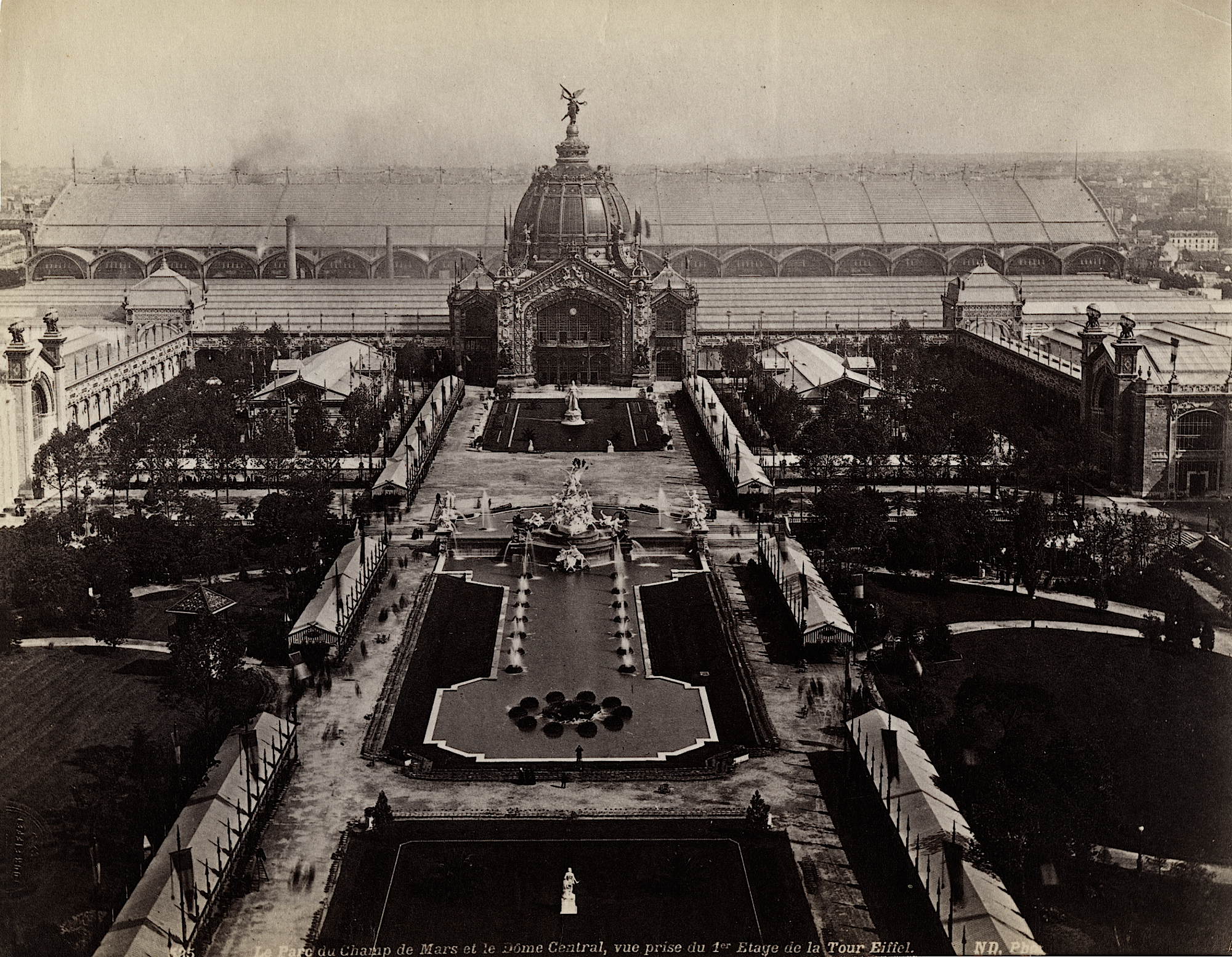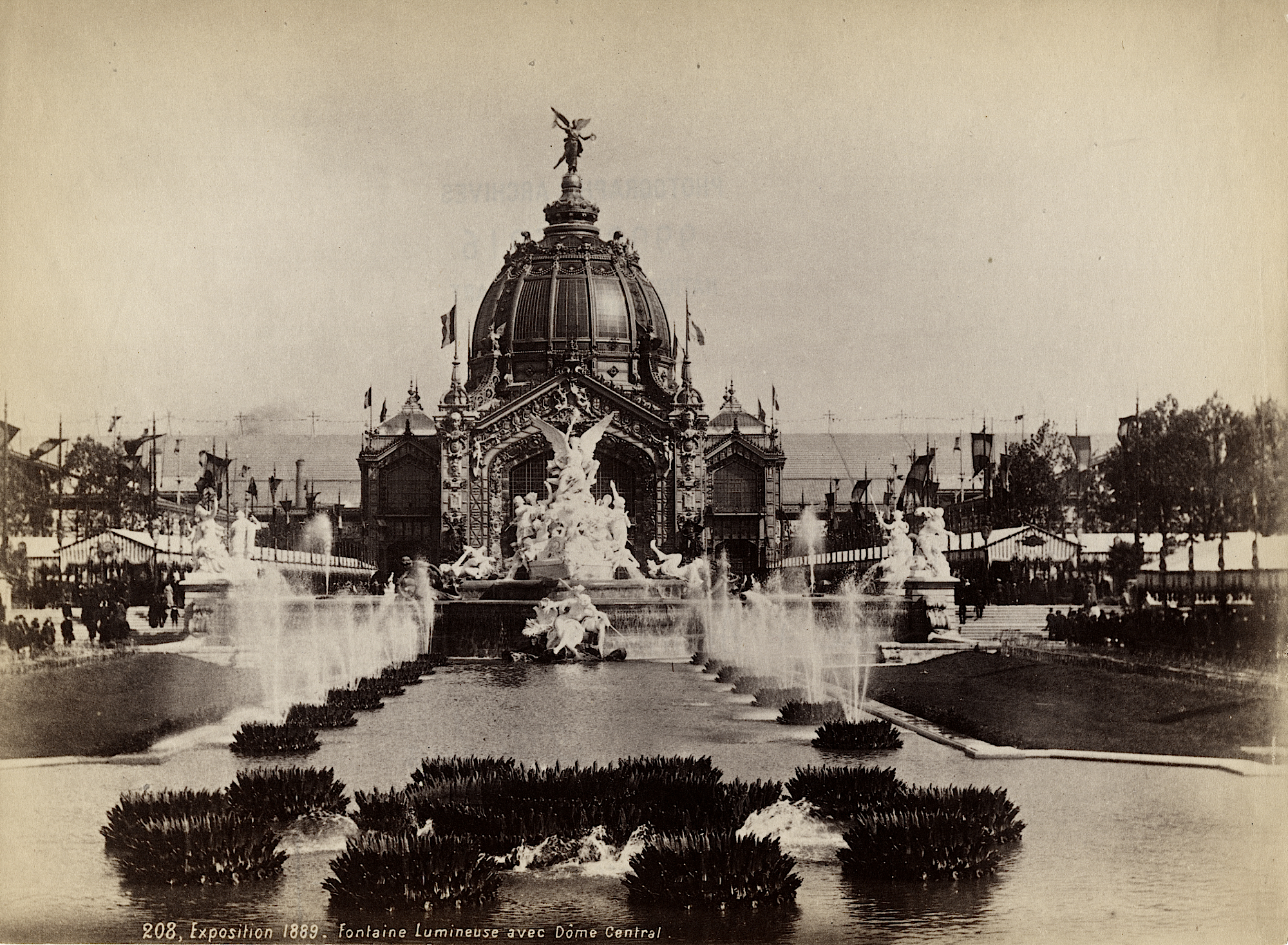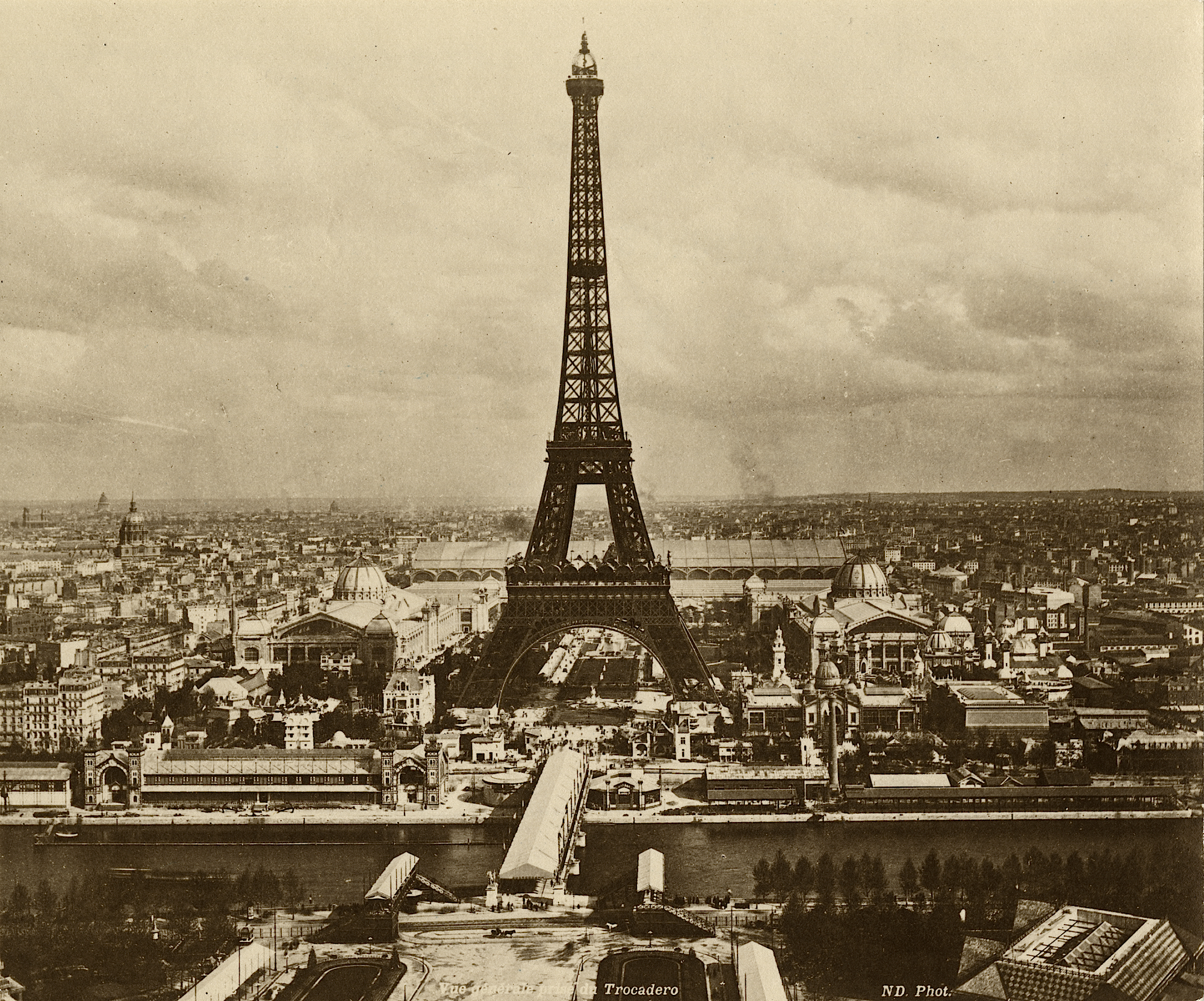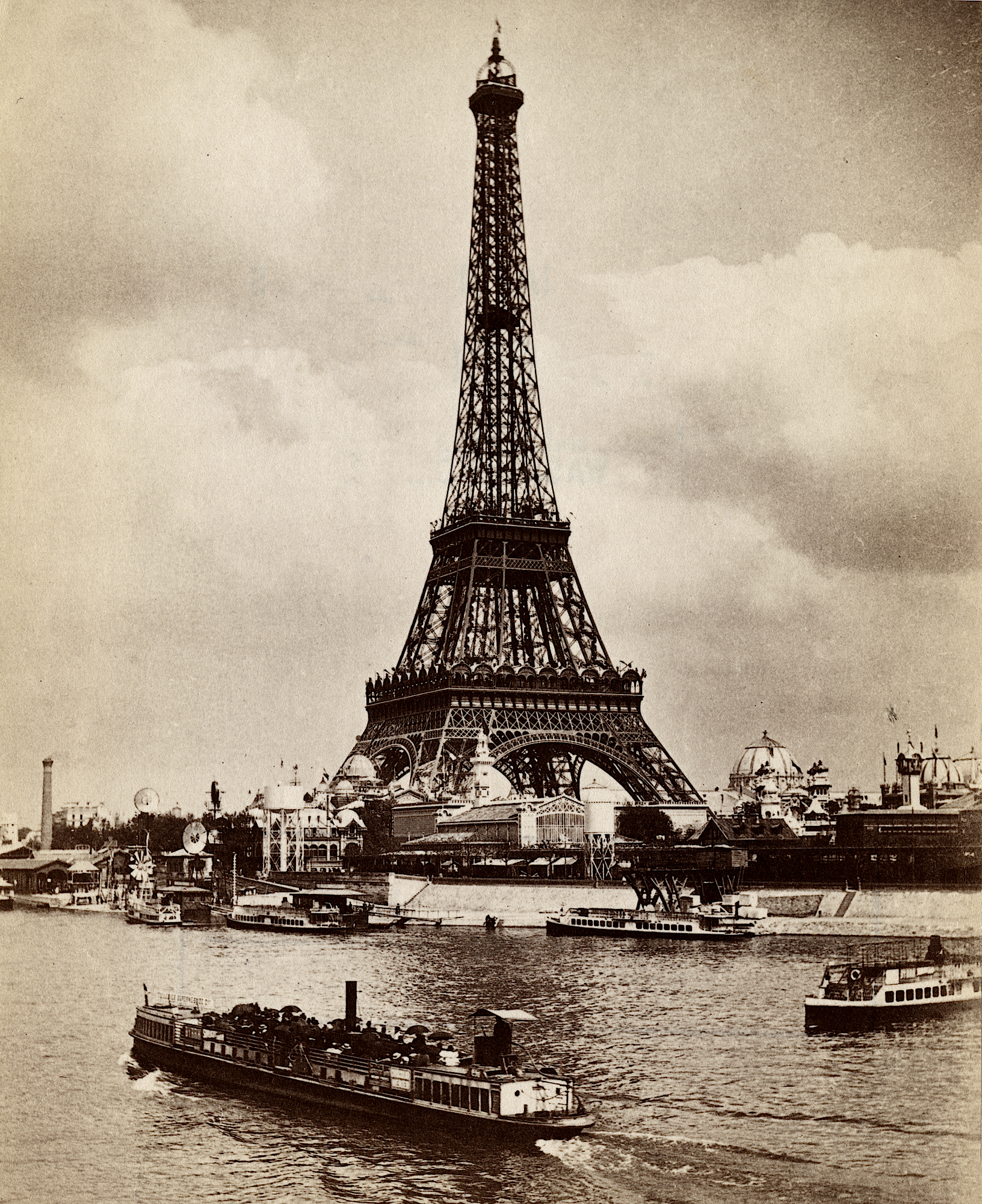Exposition Universelle de 1889: Paris, May 6–November 6, 1889

Panorama of the Champ-de-Mars
Dôme Central and Palais des Industries Diverses: Joseph Antoine Bouvard, architect
Galerie Desaix and Galerie Rapp: Jean Camille Formigé, architect
Palais des Machines: Ferdinand Dutert, engineer; Victor Contamin, architect
Fontaine Monumentale: Jules Félix Coutin, sculptor; Jean Camille Formigé, architect
This view from the first level of the Eiffel Tower shows the Dôme Central and Palais des Industries Diverses, center; the Galerie Rapp, left; and Galerie Desaix, right. Behind the Palais des Industries Diverses is the Palais des Machines (also referred to as the Galerie des Machines). In front of the Dôme Central is the Fontaine Monumentale.

Dôme Central and Fontaine Monumentale
Dôme Central: Joseph Antoine Bouvard, architect
Fontaine Monumentale: Jules Félix Coutin, architect; Jean Camille Formigé, sculptor
The elegant Dôme Central, nearly 200 feet tall, was surmounted by a 30-foot statue of France by Eugène Delaplanche. This focal point of the Champ-de-Mars was the central entry hall for the Palais des Industries Diverses.

Fontaine Monumentale
Jules Félix Coutin, sculptor; Jean Camille Formigé, architect
Also called the Fontaines Lumineuses, this fountain, near the Dôme Central, and its companion fountain beneath the Eiffel Tower performed hydraulic spectacles at 9:00 every evening. Thousands of fair visitors watched as the jets of the fountain were electrically illuminated to change color in red, blue, green, and gold.
The sculpture of this fountain depicts the city of Paris lighting up the world with its torch, surrounded by science, industry, agriculture, and art. (The official title was "La Ville de Paris, sur son vaisseau, environnée de la Science, de l'Industrie, de l'Agriculture, de l'Art, éclaire le monde de son flambeau.")

Dôme Central, interior
Joseph Antoine Bouvard, architect
View from the main entrance of the interior hall beneath the dome; beyond it is the central hall of the Palais des Industries Diverses, the Galerie de Trente Mètres (30-meter gallery).

Dôme Central, interior
Joseph Antoine Bouvard, architect
View to the left of the entrance door into the Gobelins tapestry manufacturing section. The frieze by Lavastre and Carpezat shows the people of the world arriving at the Champs-de-Mars in their national costumes. The four corners of the dome were supported on piers with medallions designating steam, electricity, air, and water.

Eiffel Tower (Tour de 300 mètres)
Gustave Eiffel, designer; Stephen Sauvestre, architect;
Maurice Koechlin and Emile Nouguier, engineers
The Eiffel Tower is the only surviving structure from the 1889 exposition. This view was taken from the Palais du Trocadéro.

Eiffel Tower (Tour de 300 mètres)
Gustave Eiffel, designer; Stephen Sauvestre, architect;
Maurice Koechlin and Emile Nouguier, engineers
View from the Seine. Gustave Eiffel’s tower was greatly criticized during its two-year construction period as being an "abomination and eyesore," its "barbarous mass" looming over the Paris skyline. When the fair opened, however, it became the most visited attraction and subsequently the grand symbol of Paris that it is today.

Palais des Arts Libéraux, from beneath the Eiffel Tower
Jean Camille Formigé, architect
The liberal arts exhibited here included archaeology, anthropology, astronomy, chemistry, physics, medicine and surgery, precision instruments, transportation, military arts, and theater. Also included were the Japanese print collection of Siegfried Bing and an extensive history of labor.

Palais des Beaux-Arts
Jean Camille Formigé, architect
Both the Palais des Beaux-Arts and the Palais des Arts Libéraux were
iron structures clad in plaster ornament. This gallery displayed
French and international paintings and sculpture.

Palais des Beaux-Arts, interior
Jean Camille Formigé, architect
View of the central sculpture gallery

Palais des Machines
Ferdinand Dutert, architect; Victor Contamin, engineer
View of the interior. This innovative iron and glass structure was the largest building in the exposition, enclosing 15 acres. Its most extensive exhibit was that of Thomas Edison’s 493 inventions. Referred to at the time as a "disconcerting industrial cathedral," the Palais des Machines was reused for the Exposition Universelle of 1900 and demolished in 1909.

Pavilion of Bolivia
Paul Fouquiau, architect
Bolivia’s mining and silver resources were highlighted in this domed and turreted pavilion.

Pavilion of Brazil
Louis Dauvergne, architect
Brazil’s pavilion was built by a Parisian architect in a neo-Portuguese nautical style, with sculpture along one side representing the rivers of Brazil. Displayed inside were exhibits illustrating Brazil's immense agricultural resources, including native chocolate and vanilla beans and sugar cane. The pavilion was surrounded by a garden of exquisite flowers, banana and palm trees, and orchids.

Pavilion of Venezuela
Edmond Jean Baptiste Paulin, architect
The Venezuelan pavilion was constructed in a highly sculptural Spanish Renaissance
revival style, with a small side veranda featuring the national colors yellow, red, and blue.

Egyptian Bazaar and Cairo Street (Rue du Caire)
This was the second most popular attraction at the exposition after the Eiffel Tower.
A Cairo street was recreated, which included 25 authentic shops and restaurants
employing scores of native Egyptian waiters, vendors, and craftsmen.

Central African and Lapland Houses
Charles Garnier, architect
At the base of the Eiffel Tower, 44 small buildings were constructed in the styles of various epochs and cultures. The architect was the famous designer of the Paris Opera, assisted by Professor Amman from the department of history and geography at the Lycée Louis-le-Grand. This view shows African and Lapland dwellings.

Persian, Germanic, and Gallic Houses
Charles Garnier, architect
Garnier’s "Habitations Humaines" re-created 44 different stylistic and ethnic periods. In this view, a Persian dwelling is on the extreme left; the center wooden structure on stilts is an early Germanic dwelling; and behind the large plant is a circular Gallic hut.

Pavilion Brault
Marcel Deslignieres, architect
Also on the Champs-de-Mars were pavilions built by commercial companies. In the foreground is the pavilion of the Brault ceramic firm, built entirely in ceramics in an early French Renaissance style. The pavilion for the Boas Frères diamond-cutting firm is in the left background.

Esplanade des Invalides
Panoramic view of the exhibitions from the French colonies

Palais des Colonies (Palace of the Colonies)
Stephen Sauvestre, architect
Central exhibition building of the French overseas colonies in Southeast Asia and Africa

Palace of Annan and Tonkin
Henri Vildieu, architect
This palace represented the protectorates of Annan and Tonkin, which, along with Cochin China, Laos, and Cambodia, were part of the recently formed federation of Indochina. Annan, Tonkin, and Cochin China were later united to become Vietnam. Architect Henri Vildieu was the adjutant-architect for civil buildings of Indochina in Saigon. The building reproduces the principal porch of the pagoda of Quan-Yen.

Pavilion of Cochin China
Alfred Foulhoux, architect
This templelike pavilion represented the French colony of Cochin China, which, along with Annan and Tonkin, later became Vietnam. Architect Alfred Foulhoux was the director of public works in Cochin China.

Pagoda of Angkor
Albert Maurice Fabre, architect
Panorama with pagoda on the left and entrance to the Javanese village on the right. The houses in the Kampong Javanais came directly from Java, as did the popular Javanese dancers. Architect Albert Maurice Fabre was the chief of public works in Phnom Penh.

Pagoda of Angkor
Albert Maurice Fabre, architect
This pagoda was styled after the Khmer temples at Angkor Wat
in what was then the French protectorate of Cambodia.